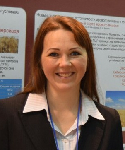| Biography | |
|---|---|
 Dr. Elena Alexandrovna Chugunova FRC Kazan Scientific Center, Russian Academy of Sciences, Russia |
|
| Title: BENZOFUROXANS AND STRUCTURALLY RELATED N-OXIDE-CONTAINING HETEROCYCLES | |
| Abstract: Benzofuroxans possess an unique combination of various chemical characteristics, such as tautomerism, ring opening, and easy transformation upon reactions with electrophilic and nucleophilic reagents. The benzofuroxan system is an excellent platform for the creation of new biologically active compounds. Taking into account the ability of benzofuroxan moiety to release NO, the design of hybrid compounds based on benzofuroxans became currently the most promising area in this field. Benzofuroxans also open a way to the production of various heterocyclic compounds, such as 2H-benzimidazole 1,3-dioxides, benzoxadiazine 4-oxides and 2H-benzimidazole mono-N-oxides. The presence of one or two NO donor moieties in the structure of these heterocycles makes the studies of these compounds being promising for the synthesis of new derivatives and the evaluation of their biological activity towards new objects. | |
| Biography:
Senior researcher of The Laboratory of organoelemental synthesis named after A.M. Pudovik, Arbuzov Institute of Organic and Physical Chemistry, FRC Kazan Scientific Center, Russian Academy of Sciences. Author of 40 publications in international peer reviewed journals. HI = 9 Professional Experience: Synthesis of new organic compounds with practically useful properties. The study of bactericidal, fungicidal activity, testing the toxicity of compounds based on nitrobenzofuroxan, the ability to suppress genotoxic effects of UV-radiation with 300-400 nanometer wavelength. The synthesis of bezofuroxan hybrids with the use of different pharmacophores such us aminoacids, sulfanilamides, polyene antibiotics, benzothiazoles and othersSynthesis of monoand di-N-oxides of 2H-benzimidazoles and study of their chemical properties. Research of the chemical transformations of 2H-benzimidazole 1,3-dioxides upon heating, obtaining of 3H2,1,4-benzoxadiazine 4-oxides and 2H-benzimidazole mono-N-oxides. The study of biological effects synthesized compounds on bacteria and fungi. | |
